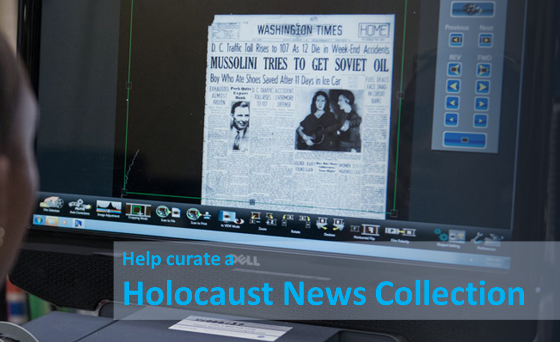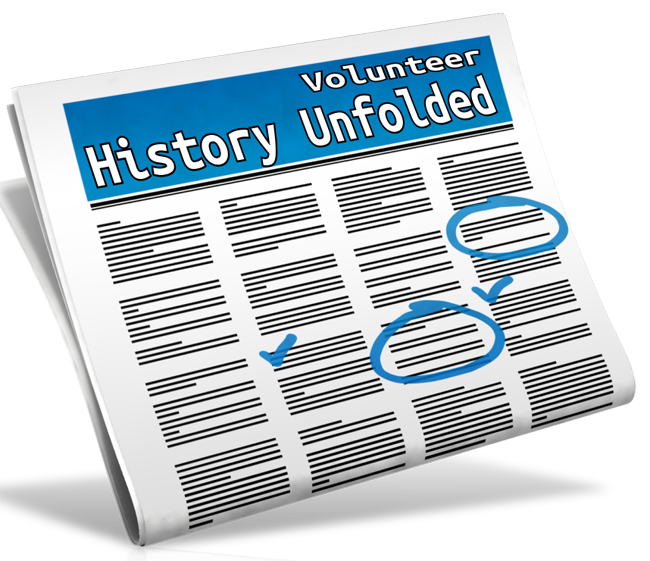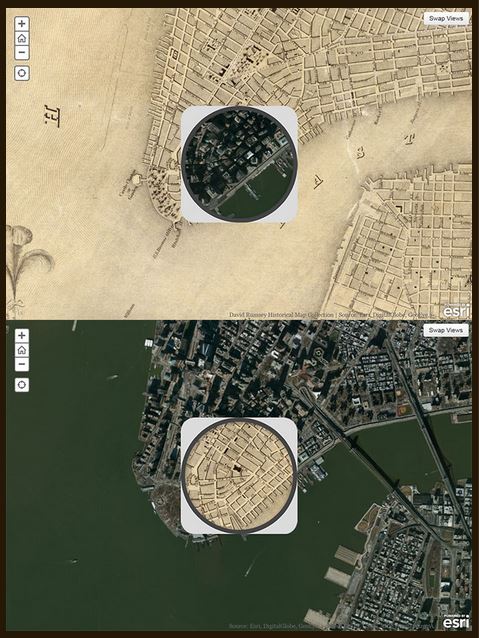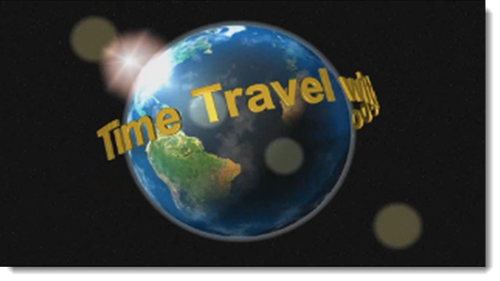by Lisa Cooke | Jun 24, 2017 | 01 What's New, Jewish, Newspaper, Volunteer
Looking for an easy way to make a big difference? Help collect Holocaust newspaper articles printed in your local newspapers for the History Unfolded project of the United States Holocaust Memorial Museum. Do it on your own, or with your local genealogical or historical society!

The following article came to us via Newspapers.com:
What is History Unfolded? History Unfolded is a project that seeks to expand our knowledge of how American newspapers reported on Nazi persecution during the 1930s and ’40s so we can better understand what Americans knew about the Holocaust as it was happening.
To help achieve this, the History Unfolded project asks people like you to search local newspapers from the 1930s and ’40s for Holocaust-related news and opinions and then submit them online to the museum. The newspaper articles you submit will be used to help shape the museum’s 2018 exhibit on Americans and the Holocaust and related educational materials. The articles will also be made available to scholars, historians, and the public.
Who Can Contribute? Everyone! History buffs, students, teachers (with) an interest in the Holocaust and access to a newspaper from the 1930s or ’40s, either online (using Newspapers.com, for example) or through a physical archive, such as a library. Simply create an account with History Unfolded (to get started.)
How Do I Contribute? History Unfolded has created a list of more than 30 Holocaust-related events to focus on. Choose one of these events to research, then search for content related to that topic in an American newspaper of your choice from the 1930s or ’40s. After you find an article related to one of the events, submit it online to the museum through the project’s website.
 Newspapers.com and History Unfolded You can contribute to this important project whether or not you use Newspapers.com to do so. But using Newspapers.com makes it even easier to submit the articles you find. Simply use Newspapers.com to create a clipping of an article you’ve found, then submit that clipping through the submission form on the History Unfolded website. The submission form has a special tool created specifically for Newspapers.com users that makes submitting your clipping a snap.
Newspapers.com and History Unfolded You can contribute to this important project whether or not you use Newspapers.com to do so. But using Newspapers.com makes it even easier to submit the articles you find. Simply use Newspapers.com to create a clipping of an article you’ve found, then submit that clipping through the submission form on the History Unfolded website. The submission form has a special tool created specifically for Newspapers.com users that makes submitting your clipping a snap.
Your help with this project will help shape our understanding of the Holocaust and the lessons it holds for us today. For more information on how to get involved, visit the History Unfolded website.
Get involved! Click here to read about more ways to volunteer in our global genealogy community. Your efforts make a huge difference.
by Lisa Cooke | Jan 13, 2014 | 01 What's New, Google, Maps

1836 map of New York City compared to modern satellite image, shown with each map in “spyglass” format. Image from David Rumsey Map Collection blog at DavidRumsey.com.
I love showing people how to use online tools to compare historical maps to modern ones. You can map out your ancestor’s address, check out their neighborhoods “then and now,” map their route to work, see if their old home still exists and more.
Well, the online Smithsonian magazine has created an exciting new interface for six American cities. Now you can compare modern satellite imagery with bird’s-eye views of:
You’ll see great city layouts before the fire that claimed much of old Chicago, the San Francisco earthquake, the Lincoln memorial and more. The historical map of New York City is the oldest, but the other maps capture each city at a critical point in their growth. For each city you can look at a historical map with a “spyglass” mouse-over of a modern satellite image, or vice-versa, as shown in the New York City map on the right. Each map is accompanied by a fantastic Smithsonian article; the historical maps come from the amazing David Rumsey Map Collection.
As many of you know, it’s possible to do something similar (or even better) with Google’s amazing mapping tools. Learn how to do that with these three Genealogy Gems resources:
1. My FREE Google Earth Video, which teaches you how to unlock mysteries in your research, from unidentified photographs to pinpointing homesteads;
2. My Google Earth 2-Disk Bundle, with detailed demonstrations and examples so you can SEE for yourself how to use Google’s mapping tools;
3. My new Time Travel with Google Earth video, in which you’ll see old maps, genealogical records, images, and videos come together to create stunning time travel experiences in Google Earth. This is available to Genealogy Gems Premium Members (learn more membership here).

by Sunny | Jan 19, 2018 | 01 What's New, Ancestry, Jewish, Military, MyHeritage
You can now find more Holocaust records online. Read here about the 1939 German Minority Census and Polish and Czech Holocaust records. Also featured this week: German vital records, new collections from Belgium and Estonia, and an update to the US War of 1812 pension...
by Lisa Cooke | Mar 27, 2015 | 01 What's New, Canadian, Digital Archives, Military, Newspaper, Photographs
We learn about great new genealogy records online every week! On Fridays we round up a few for you. Watch for databases and documents that your  ancestors might appear in–and get inspired by the types of records that may be out there for your family, waiting for you to discover. This week: a photo archives for Canadian Mennonites, a Georgia state newspaper collection, a genealogy index for a northeast Ohio archive and WWII Cadet Nursing Corps membership cards (US).
ancestors might appear in–and get inspired by the types of records that may be out there for your family, waiting for you to discover. This week: a photo archives for Canadian Mennonites, a Georgia state newspaper collection, a genealogy index for a northeast Ohio archive and WWII Cadet Nursing Corps membership cards (US).
CANADIAN MENNONITE PHOTO ARCHIVE: A new database is now online with over 80,000 images of Mennonite life from across Canada and dating back to 1860s. A press release says that the archive “is a project of the Mennonite Historical Society of Canada and includes Mennonite archival partners in British Columbia, Alberta, Saskatchewan, Manitoba, and Ontario.” An online ordering system allows visitors to order image copies for noncommercial use.
GEORGIA NEWSPAPERS: The Digital Library of Georgia has launched an archive of north Georgia historical newspapers. “The North Georgia Historic Newspapers Archive provides online access to six newspaper titles published in three north Georgia cities (Dalton, Gainesville, and Rome) from 1850 to 1922. Consisting of over 33,000 newspaper pages, the archive provides historical images that are both full-text searchable and can be browsed by date. The site is compatible with all current browsers and the newspaper page images can be viewed without the use of plug-ins or additional software downloads. The archive includes the following north Georgia newspaper titles: Gainesville News (1902-1922), Georgia Cracker (Gainesville) (1894-1902), North Georgia Citizen (Dalton) (1868-1921), Rome Courier (1850-1855), Rome Tri-Weekly Courier (1860-1880), Rome Weekly Courier (1860-1878). The Digital Library of Georgia will add additional titles from the region over time.
OHIO GENEALOGY INDEX. The Western Reserve Historical Society in Cleveland, OH has created an online Genealogy Index to some of its most valuable and unique genealogical records, including original funeral home and Bible records. Also in the index are Jewish marriages and death notices, an index of names in a significant African-American manuscript collection, a 1907 Cleveland voter registration index, a photo database of Cleveland military personnel from WWII and the Korean War and a biographical sketch name index. Currently, there are about 320,000 records in the index; more are being added on an ongoing basis. The Society primarily archives records relating to Cleveland and northeast Ohio. Soon to be added are indexes to the 1870 mortality census for Ashtabula, Ohio and indexes to several church records collections.
WWII CADET NURSING CORPS (US): The WWII Cadet Nursing Corps Card Files, new on Fold3, contain membership cards of women who joined. According to Fold3, the cards “are organized by state, nursing school, and cadet name. Some cards include the date of admission to the school, date of admission to the corps, and date of graduation (or date of other reason for termination from the school). Others contain details like the woman’s marital status, father’s/husband’s name and profession, years of college completed, place of residence, and how they heard about the corps. Still others also record the woman’s age in addition to the previously mentioned information.”
 To search for images you can use without violating copyright, do a keyword search in Google Images (or just do a keyword search from Google’s home page and then click “Images” above your search results). Click Search Tools. Another toolbar will pop up. Click “Usage rights.” You can sort search results by those that are labeled for reuse in different ways. You won’t capture every copyright-free image, but hopefully you’ll get a decent selection of options! This tip comes to you courtesy of the book The Genealogist’s Google Toolbox, Second Edition by Lisa Louise Cooke–the fully-revised 2015 edition that’s packed with strategies that will dramatically improve your ability to find your family history online.
To search for images you can use without violating copyright, do a keyword search in Google Images (or just do a keyword search from Google’s home page and then click “Images” above your search results). Click Search Tools. Another toolbar will pop up. Click “Usage rights.” You can sort search results by those that are labeled for reuse in different ways. You won’t capture every copyright-free image, but hopefully you’ll get a decent selection of options! This tip comes to you courtesy of the book The Genealogist’s Google Toolbox, Second Edition by Lisa Louise Cooke–the fully-revised 2015 edition that’s packed with strategies that will dramatically improve your ability to find your family history online.

 Newspapers.com and History Unfolded You can contribute to this important project whether or not you use Newspapers.com to do so. But using Newspapers.com makes it even easier to submit the articles you find. Simply use Newspapers.com to create a clipping of an article you’ve found, then submit that clipping through the submission form on the History Unfolded website. The submission form has a special tool created specifically for Newspapers.com users that makes submitting your clipping a snap.
Newspapers.com and History Unfolded You can contribute to this important project whether or not you use Newspapers.com to do so. But using Newspapers.com makes it even easier to submit the articles you find. Simply use Newspapers.com to create a clipping of an article you’ve found, then submit that clipping through the submission form on the History Unfolded website. The submission form has a special tool created specifically for Newspapers.com users that makes submitting your clipping a snap.


 ancestors might appear in–and get inspired by the types of records that may be out there for your family, waiting for you to discover. This week: a photo archives for Canadian Mennonites, a Georgia state newspaper collection, a genealogy index for a northeast Ohio archive and WWII Cadet Nursing Corps membership cards (US).
ancestors might appear in–and get inspired by the types of records that may be out there for your family, waiting for you to discover. This week: a photo archives for Canadian Mennonites, a Georgia state newspaper collection, a genealogy index for a northeast Ohio archive and WWII Cadet Nursing Corps membership cards (US). To search for images you can use without violating copyright, do a keyword search in Google Images (or just do a keyword search from Google’s home page and then click “Images” above your search results). Click Search Tools. Another toolbar will pop up. Click “Usage rights.” You can sort search results by those that are labeled for reuse in different ways. You won’t capture every copyright-free image, but hopefully you’ll get a decent selection of options! This tip comes to you courtesy of the book
To search for images you can use without violating copyright, do a keyword search in Google Images (or just do a keyword search from Google’s home page and then click “Images” above your search results). Click Search Tools. Another toolbar will pop up. Click “Usage rights.” You can sort search results by those that are labeled for reuse in different ways. You won’t capture every copyright-free image, but hopefully you’ll get a decent selection of options! This tip comes to you courtesy of the book